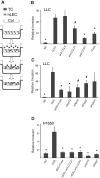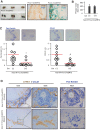A critical role for lymphatic endothelial heparan sulfate in lymph node metastasis
- PMID: 21172016
- PMCID: PMC3019167
- DOI: 10.1186/1476-4598-9-316
A critical role for lymphatic endothelial heparan sulfate in lymph node metastasis
Abstract
Background: Lymph node metastasis constitutes a key event in tumor progression. The molecular control of this process is poorly understood. Heparan sulfate is a linear polysaccharide consisting of unique sulfate-modified disaccharide repeats that allow the glycan to bind a variety of proteins, including chemokines. While some chemokines may drive lymphatic trafficking of tumor cells, the functional and genetic importance of heparan sulfate as a possible mediator of chemokine actions in lymphatic metastasis has not been reported.
Results: We applied a loss-of-function genetic approach employing lymphatic endothelial conditional mutations in heparan sulfate biosynthesis to study the effects on tumor-lymphatic trafficking and lymph node metastasis. Lymphatic endothelial deficiency in N-deacetylase/N-sulfotransferase-1 (Ndst1), a key enzyme involved in sulfating nascent heparan sulfate chains, resulted in altered lymph node metastasis in tumor-bearing gene targeted mice. This occurred in mice harboring either a pan-endothelial Ndst1 mutation or an inducible lymphatic-endothelial specific mutation in Ndst1. In addition to a marked reduction in tumor metastases to the regional lymph nodes in mutant mice, specific immuno-localization of CCL21, a heparin-binding chemokine known to regulate leukocyte and possibly tumor-cell traffic, showed a marked reduction in its ability to associate with tumor cells in mutant lymph nodes. In vitro modified chemotaxis studies targeting heparan sulfate biosynthesis in lymphatic endothelial cells revealed that heparan sulfate secreted by lymphatic endothelium is required for CCL21-dependent directional migration of murine as well as human lung carcinoma cells toward the targeted lymphatic endothelium. Lymphatic heparan sulfate was also required for binding of CCL21 to its receptor CCR7 on tumor cells as well as the activation of migration signaling pathways in tumor cells exposed to lymphatic conditioned medium. Finally, lymphatic cell-surface heparan sulfate facilitated receptor-dependent binding and concentration of CCL21 on the lymphatic endothelium, thereby serving as a mechanism to generate lymphatic chemokine gradients.
Conclusions: This work demonstrates the genetic importance of host lymphatic heparan sulfate in mediating chemokine dependent tumor-cell traffic in the lymphatic microenvironment. The impact on chemokine dependent lymphatic metastasis may guide novel therapeutic strategies.
Figures








Similar articles
-
Shape and Function of Interstitial Chemokine CCL21 Gradients Are Independent of Heparan Sulfates Produced by Lymphatic Endothelium.Front Immunol. 2021 Feb 25;12:630002. doi: 10.3389/fimmu.2021.630002. eCollection 2021. Front Immunol. 2021. PMID: 33717158 Free PMC article.
-
Lymphatic Metastasis of NSCLC Involves Chemotaxis Effects of Lymphatic Endothelial Cells through the CCR7-CCL21 Axis Modulated by TNF-α.Genes (Basel). 2020 Nov 4;11(11):1309. doi: 10.3390/genes11111309. Genes (Basel). 2020. PMID: 33158173 Free PMC article.
-
Glycan Sulfation Modulates Dendritic Cell Biology and Tumor Growth.Neoplasia. 2016 May;18(5):294-306. doi: 10.1016/j.neo.2016.04.004. Neoplasia. 2016. PMID: 27237321 Free PMC article.
-
[Progress in targeting therapy of cancer metastasis by CCL21/CCR7 axis].Sheng Wu Gong Cheng Xue Bao. 2020 Dec 25;36(12):2741-2754. doi: 10.13345/j.cjb.200174. Sheng Wu Gong Cheng Xue Bao. 2020. PMID: 33398969 Review. Chinese.
-
Cell traffic and the lymphatic endothelium.Ann N Y Acad Sci. 2008;1131:119-33. doi: 10.1196/annals.1413.011. Ann N Y Acad Sci. 2008. PMID: 18519965 Review.
Cited by
-
A general method for site specific fluorescent labeling of recombinant chemokines.PLoS One. 2014 Jan 28;9(1):e81454. doi: 10.1371/journal.pone.0081454. eCollection 2014. PLoS One. 2014. PMID: 24489642 Free PMC article.
-
Novel insights into the roles of migrasome in cancer.Discov Oncol. 2024 May 15;15(1):166. doi: 10.1007/s12672-024-00942-0. Discov Oncol. 2024. PMID: 38748047 Free PMC article. Review.
-
The role of the VEGF-C/VEGFRs axis in tumor progression and therapy.Int J Mol Sci. 2012 Dec 20;14(1):88-107. doi: 10.3390/ijms14010088. Int J Mol Sci. 2012. PMID: 23344023 Free PMC article. Review.
-
Lymphatic Regulation of Cellular Trafficking.J Clin Cell Immunol. 2014 Oct 1;5:258. doi: 10.4172/2155-9899.1000258. J Clin Cell Immunol. 2014. PMID: 27808282 Free PMC article.
-
Lymphatic specific disruption in the fine structure of heparan sulfate inhibits dendritic cell traffic and functional T cell responses in the lymph node.J Immunol. 2014 Mar 1;192(5):2133-42. doi: 10.4049/jimmunol.1301286. Epub 2014 Feb 3. J Immunol. 2014. PMID: 24493818 Free PMC article.
References
-
- Effenberger KE, Sienel W, Pantel K. Lymph node micrometastases in lung cancer. Cancer Treat Res. 2007;135:167–175. full_text. - PubMed
Publication types
MeSH terms
Substances
Grants and funding
LinkOut - more resources
Full Text Sources
Molecular Biology Databases

